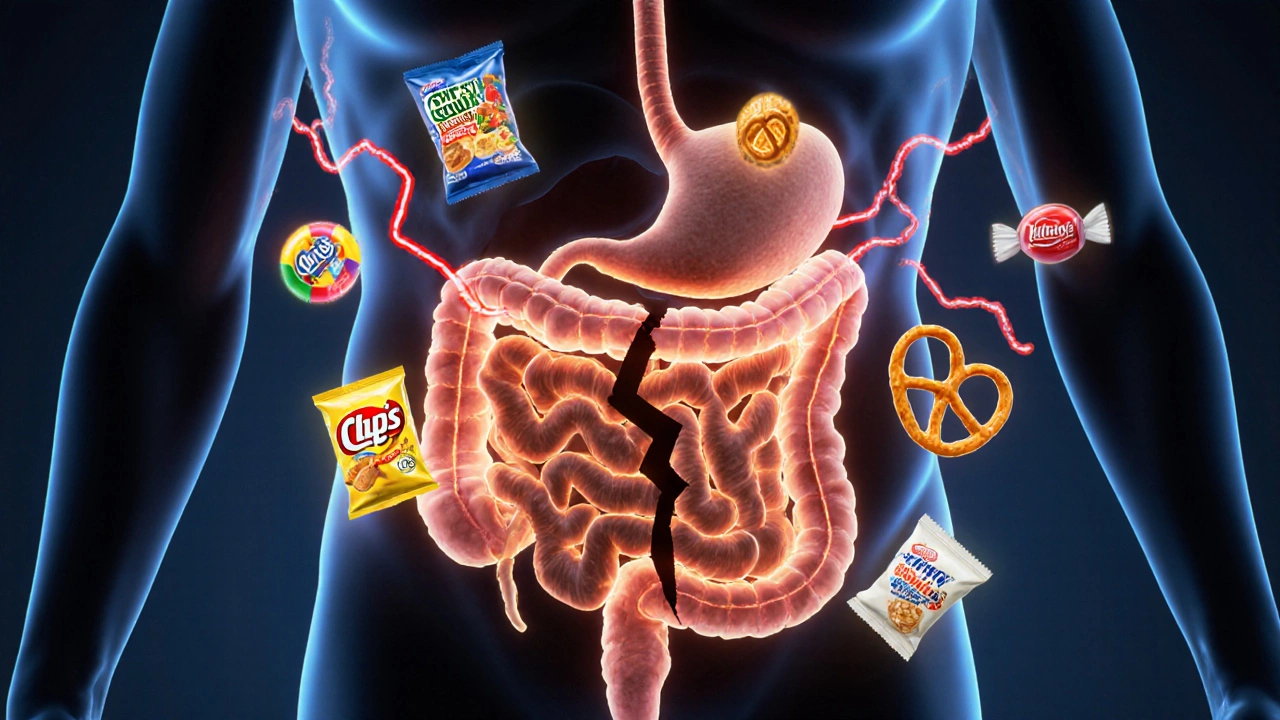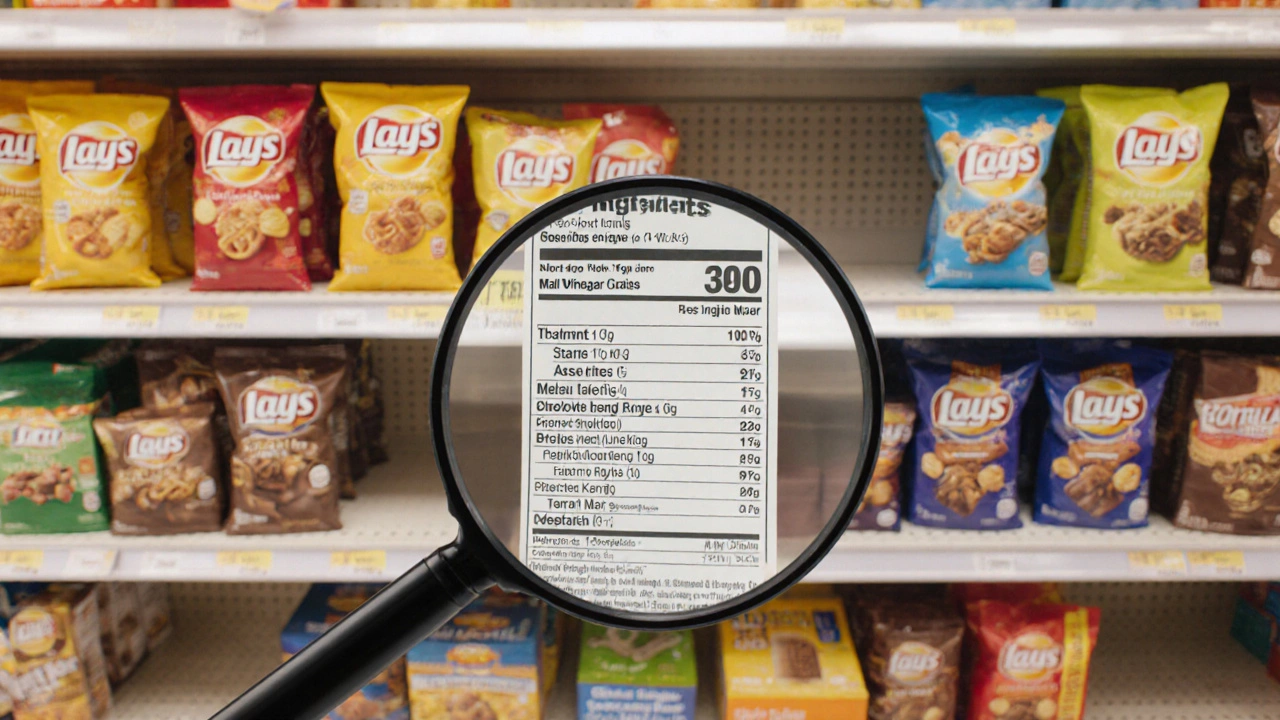Ever grabbed a bag of chips or a candy bar thinking it was safe-only to feel bloated, tired, or sick later? You’re not alone. Many people assume junk food is just sugar and fat, but gluten hides in places you’d never expect. If you’re avoiding gluten, knowing what junk food contains it can save you from uncomfortable reactions and accidental exposure.
Gluten isn’t just in bread
Gluten is a protein found in wheat, barley, rye, and sometimes oats due to cross-contamination. Most people think it’s only in pasta, bread, or cookies. But processed snacks? Those are where gluten sneaks in. Manufacturers use gluten as a thickener, binder, flavor enhancer, or texture booster. It’s cheap, effective, and everywhere.
Take flavored chips, for example. A bag of barbecue or sour cream & onion chips might have malt vinegar, wheat starch, or soy sauce in the seasoning. Even if the base is just potato and oil, the flavoring can be loaded with gluten. Same goes for pretzels, crackers, and even some popcorn brands that use malt flavoring.
Top junk foods that commonly contain gluten
- Crackers and crispbreads - Even those labeled "baked" or "low-fat" often contain wheat flour. Always check the ingredient list for wheat, barley, or malt.
- Flavored potato chips - Barbecue, ranch, and cheese flavors frequently include wheat starch or maltodextrin derived from wheat.
- Pretzels - Almost all traditional pretzels are made with wheat flour. Gluten-free pretzels exist, but they’re not the norm.
- Granola bars and cereal bars - Many contain oats (unless certified gluten-free), wheat germ, or barley syrup. Even "healthy" bars like Nature Valley or Clif Bars often have gluten.
- Chocolate bars - Some brands add wheat flour as a filler. Others are processed on shared equipment with gluten-containing products. Look for "certified gluten-free" on the label.
- Ice cream cones and waffle cones - These are almost always made with wheat flour. Even if the ice cream itself is gluten-free, the cone isn’t.
- French fries - In many restaurants, fries are cooked in the same oil as breaded items like chicken nuggets or onion rings. Cross-contamination is real.
- Processed meats like sausages and deli meats - Some brands use wheat-based fillers or breadcrumbs as extenders. Always read the fine print.
- Soy sauce and condiments - Regular soy sauce contains wheat. Teriyaki, hoisin, and some salad dressings do too.
- Energy bars and protein bars - Brands like Gatorade bars, PowerBars, and many store-brand options contain wheat protein or barley extract.
What about candy?
Plain hard candies, gummy bears, and chocolate without fillings are often gluten-free-but don’t assume. Some candies use wheat starch as a coating or anti-caking agent. For example:
- M&Ms - Regular milk chocolate M&Ms are gluten-free in the U.S. and Australia, but seasonal varieties (like Halloween or Christmas) sometimes aren’t.
- Reese’s Peanut Butter Cups - The original cups are gluten-free, but the pretzel-filled or seasonal shapes are not.
- Twizzlers - These licorice candies contain wheat flour. Don’t be fooled by the bright color.
- Kit Kat - Standard Kit Kats in the U.S. and Australia contain wheat. Gluten-free versions exist but are sold separately.
Always check the manufacturer’s website. Brands update ingredients without changing packaging. A candy that was gluten-free last year might have a new recipe this year.

Why you can’t trust "may contain" labels
Some packages say "may contain traces of wheat" or "processed in a facility with gluten." These are warnings for people with severe allergies, not necessarily gluten intolerance. But if you have celiac disease, even tiny amounts can damage your gut lining.
For celiac sufferers, only products labeled "certified gluten-free" are safe. That certification means the product has been tested and contains less than 20 parts per million (ppm) of gluten-the international safety standard. Brands like Enjoy Life, Glutino, and Bob’s Red Mill follow these rules.
But here’s the catch: many junk food companies don’t bother with certification. It’s expensive. So even if the ingredients look clean, the risk of cross-contamination is high. That’s why you can’t rely on guesswork.
How to spot gluten on labels
Gluten hides under dozens of names. Here’s what to look for:
- Wheat (including wheat starch, wheat flour, wheat protein)
- Barley (malt, malt extract, malt flavoring, malt syrup)
- Rye
- Oats (unless labeled gluten-free)
- Modified food starch (if source isn’t specified)
- Dextrin (sometimes from wheat)
- Hydrolyzed vegetable protein (HVP)
- Textured vegetable protein (TVP)
- Soy sauce (unless it’s tamari or gluten-free labeled)
- Vegetable gum (sometimes wheat-derived)
If you see "natural flavors" or "spices," they could also contain gluten. In Australia and the U.S., manufacturers must list wheat, but not barley or rye. That’s why you need to know the hidden names.
Gluten-free junk food options you can actually enjoy
Yes, there are safe junk foods out there. You just need to know where to look:
- Popcorn - Plain, air-popped popcorn is naturally gluten-free. Brands like SkinnyPop and Popcorn Indiana have certified gluten-free lines.
- Some chips - Late July, Kettle Brand, and Terra offer certified gluten-free flavors. Stick to simple salted or sea salt varieties.
- Dark chocolate - Lindt Excellence 70% and higher, Green & Black’s, and Endangered Species bars are often gluten-free. Always check the label.
- Gluten-free pretzels - Snyder’s of Hanover makes a certified gluten-free version.
- Gluten-free candy - Smarties, Skittles, and Jelly Belly jelly beans are gluten-free. Enjoy Life also makes allergen-free chocolate bites.
- Coconut chips and dried fruit - Look for unsweetened, no-additive versions.
Remember: just because a snack is labeled "gluten-free" doesn’t mean it’s healthy. Many gluten-free junk foods are loaded with sugar, salt, and processed oils. But if you’re avoiding gluten, these are your best bets for occasional treats.

What to do when you’re unsure
When you’re at a convenience store, movie theater, or gas station and you’re not sure:
- Check the manufacturer’s website using your phone. Most have a gluten-free product list.
- Call their customer service line. They’re required to answer ingredient questions.
- When in doubt, skip it. A few minutes of hunger is better than hours of discomfort.
- Carry a few certified gluten-free snacks with you. That way, you’re never caught off guard.
It takes time to learn what’s safe. Start with a few trusted brands. Build your own list. Over time, you’ll recognize patterns. You’ll stop needing to check every label-because you’ll just know.
Why this matters beyond the gut
Gluten isn’t just about stomach pain. For people with celiac disease, eating gluten triggers an immune response that damages the small intestine. That leads to nutrient malabsorption, fatigue, brain fog, and long-term health risks like osteoporosis and certain cancers.
Even if you don’t have celiac, non-celiac gluten sensitivity is real. Symptoms include bloating, headaches, joint pain, and skin rashes. Avoiding gluten can improve energy, sleep, and mental clarity.
Knowing what junk food has gluten isn’t about being perfect. It’s about being informed. It’s about giving your body the chance to heal and thrive-even when you’re craving something salty or sweet.
Do all chips have gluten?
No, plain, unflavored potato chips made with just potato, oil, and salt are naturally gluten-free. But flavored chips often contain gluten in seasonings like malt vinegar, wheat starch, or soy sauce. Always check the label or look for certified gluten-free brands.
Is popcorn gluten-free?
Plain air-popped popcorn is gluten-free. But microwave popcorn and flavored varieties can contain gluten in butter substitutes, seasonings, or flavorings. Brands like SkinnyPop and Popcorn Indiana offer certified gluten-free options.
Does chocolate have gluten?
Pure dark chocolate is usually gluten-free, but many chocolate bars include wheat flour, barley malt, or are processed on shared equipment. Always check for a "certified gluten-free" label. Brands like Lindt and Enjoy Life are safe bets.
Are M&Ms gluten-free?
Regular milk chocolate M&Ms in the U.S. and Australia are gluten-free, but seasonal or special edition varieties (like Halloween or Christmas) may contain gluten. Always check the ingredient list on the package or the Mars website.
Can I eat fries at a restaurant?
Most restaurant fries are cooked in the same oil as breaded items like chicken nuggets or onion rings, which causes cross-contamination. Even if the fries themselves don’t contain gluten, they’re not safe unless the restaurant uses a dedicated fryer. Ask if they have a separate fryer for gluten-free items.
What’s the difference between gluten-free and certified gluten-free?
"Gluten-free" means the manufacturer claims the product has no gluten, but there’s no testing involved. "Certified gluten-free" means an independent organization tested the product and confirmed it contains less than 20 parts per million of gluten-the safety standard for people with celiac disease. Always choose certified when possible.
Final tip: Build your own safe list
Keep a note on your phone with the gluten-free junk foods you’ve tested and trusted. Include the brand, flavor, and where you bought it. Over time, you’ll stop wondering. You’ll know. And that’s the real win-not just avoiding gluten, but enjoying food without fear.

